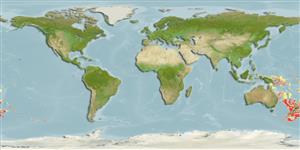Holocephali (Chimären, Seekatzen) (chimaeras) >
Chimaeriformes (Chimaeras) >
Chimaeridae (Shortnose chimaeras or ratfishes)
Etymology: Hydrolagus: hydro-, combining form of hydor (Gr.), water; lagos (Gr.), hare, i.e., “water rabbit,” probably referring to three pairs of tooth plates, which tend to protrude from the mouth like a rabbit’s incisors. (See ETYFish); trolli: In honor of American artist Ray Troll (b. 1954), Ketchikan, Alaska (USA), “one of the few true chimaeroid lovers of the world ... for his valiant efforts to increase ratfish awareness worldwide”. (See ETYFish).
Environment: milieu / climate zone / depth range / distribution range
Ökologie
seewasser bathydemersal; tiefenbereich 612 - 1707 m (Ref. 45071). Deep-water
Western Pacific: New Caledonia and New Zealand.
Size / Gewicht / Alter
Maturity: Lm ? range ? - ? cm
Max length : 112 cm TL Männchen/unbestimmt; (Ref. 45071); 120.4 cm TL (female); max. veröff. Gewicht: 8.8 kg (Ref. 122636)
Kurzbeschreibung
Morphologie | Morphometrie
Body blue-gray with a dark line around the orbit and dark shadowing along edges of lateral-line canals. Snout pointed. Preopercular and oral lateral-line canals sharing a common branch. D1 concave with pale margin. Males with frontal tenaculum deeply curved, upturned distally with spines along dorsal upturned edge. Prepelvic tenacula deeply indented along distal margin. Pelvic claspers with pale fleshy distal lobes, divided distally for 1/3 their length, tips usually extending beyond distal edge of pelvic fins. Ventral caudal fin not deeply indented at its origin to form a separate anal fin.
Oviparous (Ref. 205). Eggs are encased in horny shells (Ref. 205). Reported sexual maturity at 550-65.0 cm BDL or body length (Ref. 116866).
Life cycle and mating behavior
Geschlechtsreife | Fortpflanzung | Ablaichen | Eier | Fecundity | Larven
Didier, D.A. and B. Séret, 2002. Chimaeroid fishes of New Caledonia with description of a new species of Hydrolagus (Chondrichthyes, Holocephali). Cybium 26(3):225-233. (Ref. 45071)
IUCN Rote Liste Status (Ref. 130435)
Bedrohung für Menschen
Harmless
Nutzung durch Menschen
Mehr Information
ReferenzenAquakulturAquakultur ProfilZuchtlinienGenetikElectrophoresesVererbbarkeitKrankheitenVerarbeitungNutrientsMass conversion
PartnerBilderStamps, Coins Misc.LauteCiguateraGeschwindigkeitSchwimmstilKiemenoberflächeOtolithsGehirngrößeSehfähigkeit
Tools
Zusatzinformationen
Download XML
Internet Quellen
Estimates based on models
Preferred temperature (Ref.
123201): 3.4 - 6.9, mean 4.8 °C (based on 322 cells).
Phylogenetic diversity index (Ref.
82804): PD
50 = 0.5000 [Uniqueness, from 0.5 = low to 2.0 = high].
Bayesian length-weight: a=0.00282 (0.00118 - 0.00673), b=3.10 (2.89 - 3.31), in cm total length, based on LWR estimates for this (Sub)family-body shape (Ref.
93245).
Trophic level (Ref.
69278): 4.0 ±0.6 se; based on size and trophs of closest relatives
Widerstandsfähigkeit (Ref.
120179): niedrig, Verdopplung der Population dauert 4,5 - 14 Jahre. (Assuming Fec <100).
Fishing Vulnerability (Ref.
59153): High to very high vulnerability (72 of 100).
